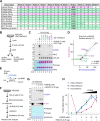This is a preprint.
Reversible histone deacetylase activity catalyzes lysine acylation
- PMID: 38014285
- PMCID: PMC10680841
- DOI: 10.1101/2023.11.17.567549
Reversible histone deacetylase activity catalyzes lysine acylation
Update in
-
Reversible histone deacetylase activity catalyzes lysine acylation.Nat Chem Biol. 2025 Mar 26. doi: 10.1038/s41589-025-01869-5. Online ahead of print. Nat Chem Biol. 2025. PMID: 40140626
Abstract
Starvation and low carbohydrate diets lead to the accumulation of the ketone body, β-hydroxybutyrate (BHB), whose blood concentrations increase more than 10-fold into the millimolar range. In addition to providing a carbon source, BHB accumulation triggers lysine β-hydroxybutyrylation (Kbhb) of proteins via unknown mechanisms. As with other lysine acylation events, Kbhb marks can be removed by histone deacetylases (HDACs). Here, we report that class I HDACs unexpectedly catalyze protein lysine modification with β-hydroxybutyrate (BHB). Mutational analyses of the HDAC2 active site reveal a shared reliance on key amino acids for classical deacetylation and non-canonical HDAC-catalyzed β-hydroxybutyrylation. Also consistent with reverse HDAC activity, Kbhb formation is driven by mass action and substrate availability. This reverse HDAC activity is not limited to BHB but also extends to multiple short-chain fatty acids. The reversible activity of class I HDACs described here represents a novel mechanism of PTM deposition relevant to metabolically-sensitive proteome modifications.
Conflict of interest statement
Declaration of Interests The authors declare no competing interests.
Figures





Similar articles
-
Reversible histone deacetylase activity catalyzes lysine acylation.Nat Chem Biol. 2025 Mar 26. doi: 10.1038/s41589-025-01869-5. Online ahead of print. Nat Chem Biol. 2025. PMID: 40140626
-
Non-specific recognition of histone modifications by H3K9bhb antibody.bioRxiv [Preprint]. 2023 Apr 13:2023.04.12.536655. doi: 10.1101/2023.04.12.536655. bioRxiv. 2023. Update in: iScience. 2023 Jun 29;26(7):107235. doi: 10.1016/j.isci.2023.107235. PMID: 37090555 Free PMC article. Updated. Preprint.
-
Quantitative Proteomics Analysis Expands the Roles of Lysine β-Hydroxybutyrylation Pathway in Response to Environmental β-Hydroxybutyrate.Oxid Med Cell Longev. 2022 Feb 24;2022:4592170. doi: 10.1155/2022/4592170. eCollection 2022. Oxid Med Cell Longev. 2022. PMID: 35251473 Free PMC article.
-
Function and mechanism of histone β-hydroxybutyrylation in health and disease.Front Immunol. 2022 Sep 12;13:981285. doi: 10.3389/fimmu.2022.981285. eCollection 2022. Front Immunol. 2022. PMID: 36172354 Free PMC article. Review.
-
The proteomic effects of ketone bodies: implications for proteostasis and brain proteinopathies.Front Mol Neurosci. 2023 Jul 27;16:1214092. doi: 10.3389/fnmol.2023.1214092. eCollection 2023. Front Mol Neurosci. 2023. PMID: 37575967 Free PMC article. Review.
Cited by
-
Ketone bodies as chemical signals for the immune system.Am J Physiol Cell Physiol. 2024 Mar 1;326(3):C707-C711. doi: 10.1152/ajpcell.00478.2023. Epub 2024 Jan 8. Am J Physiol Cell Physiol. 2024. PMID: 38189135 Free PMC article.
References
-
- Taggart A. K. et al., (D)-beta-Hydroxybutyrate inhibits adipocyte lipolysis via the nicotinic acid receptor PUMA-G. J Biol Chem 280, 26649–26652 (2005). - PubMed
Publication types
Grants and funding
LinkOut - more resources
Full Text Sources
Research Materials
